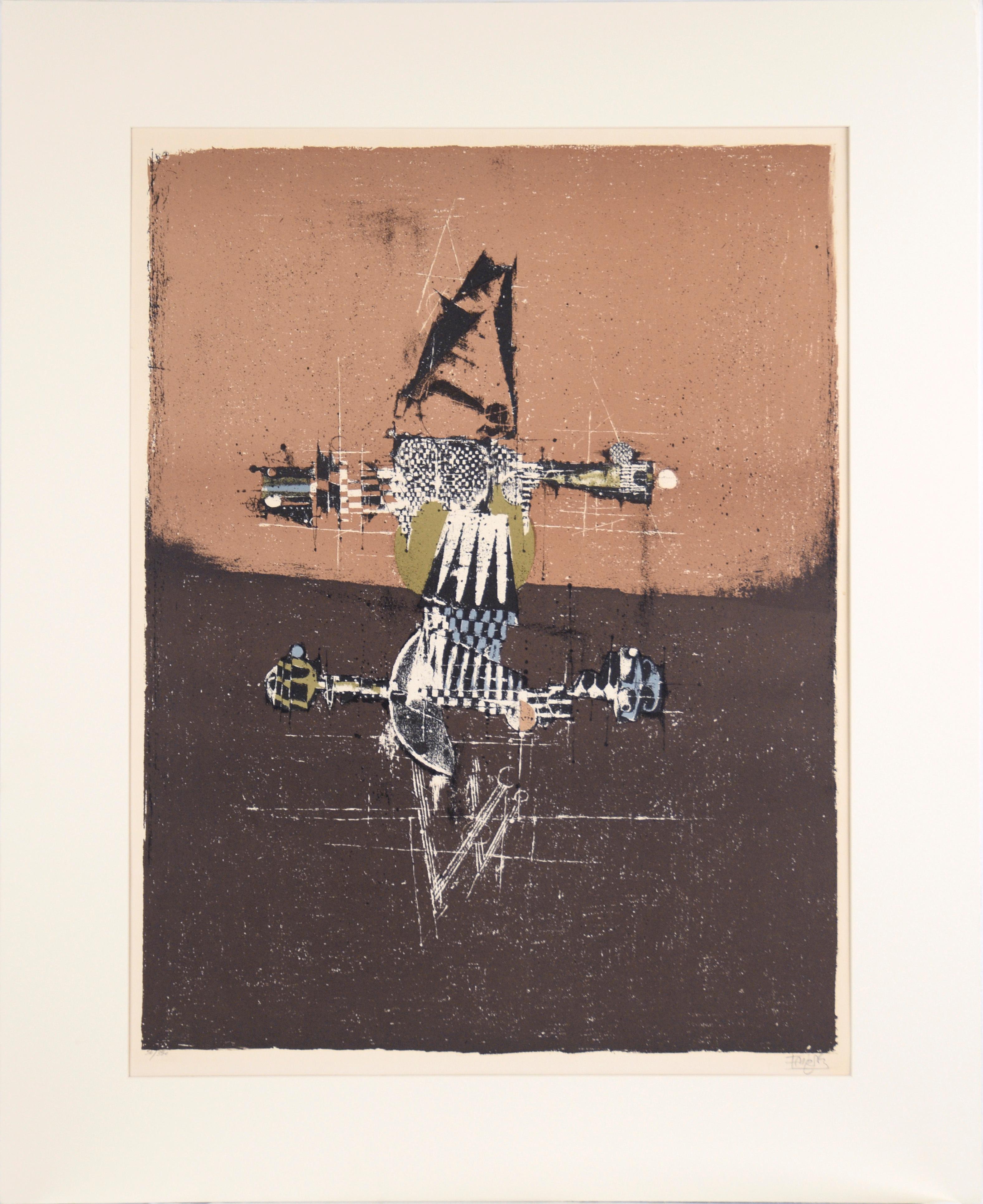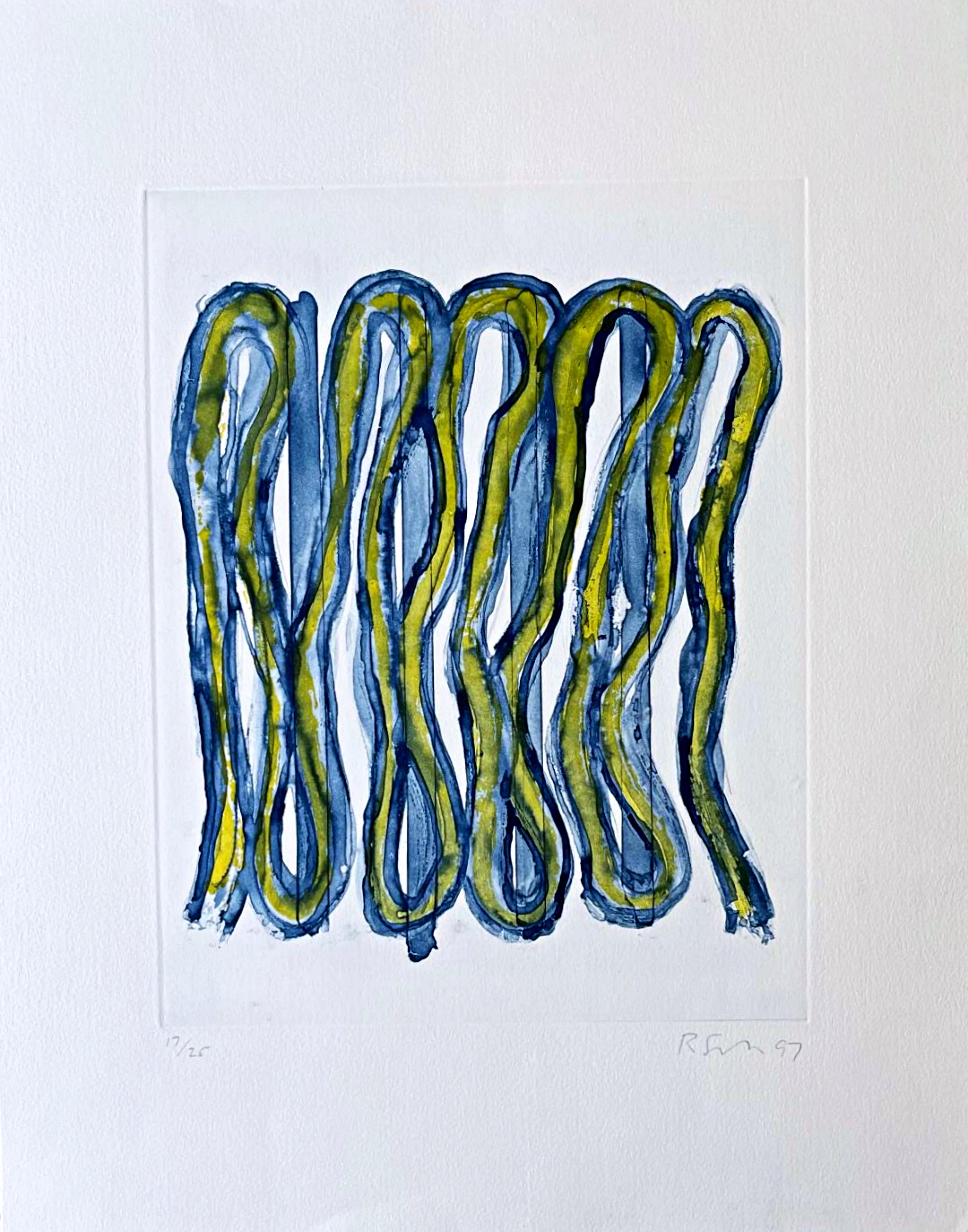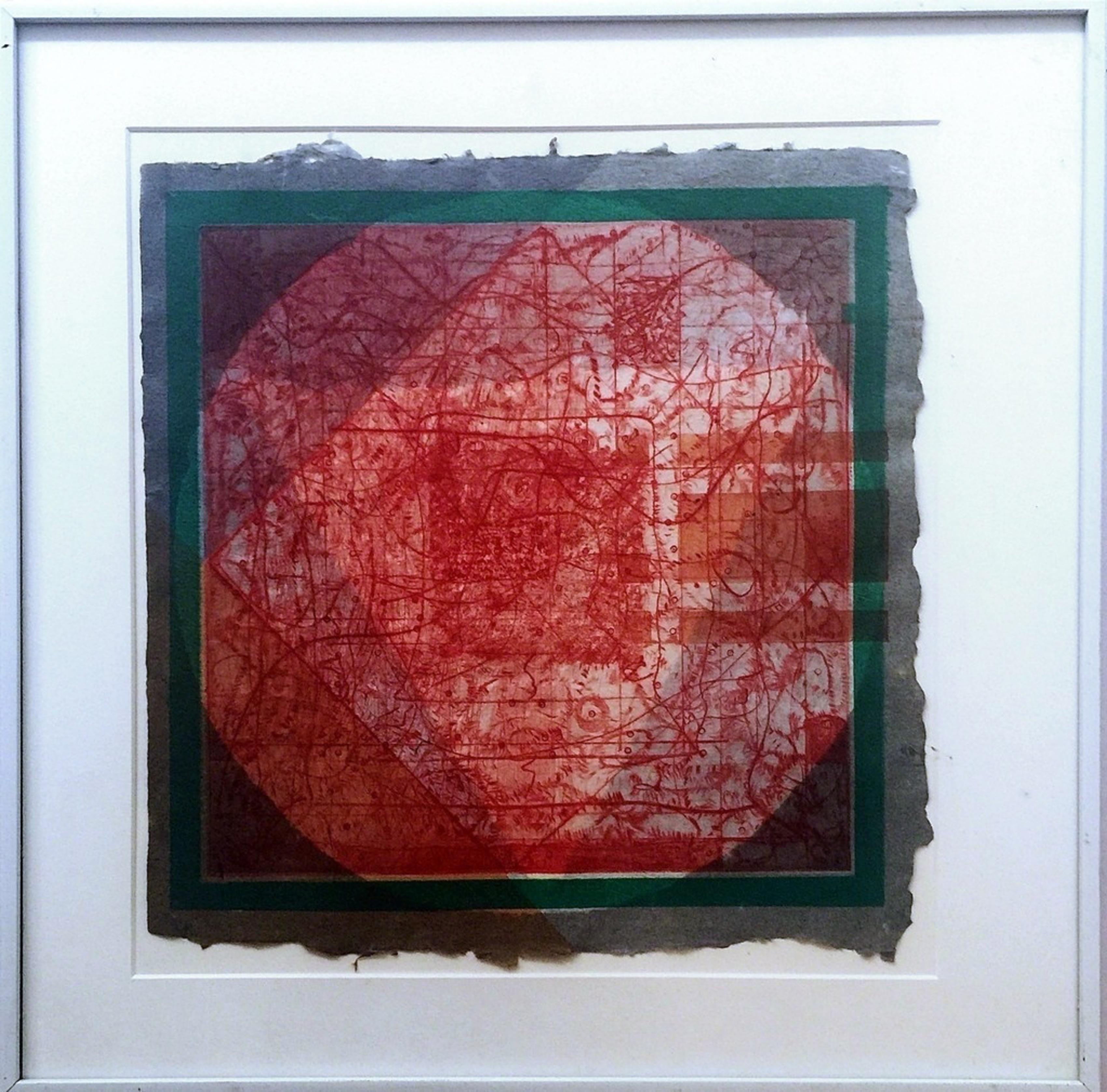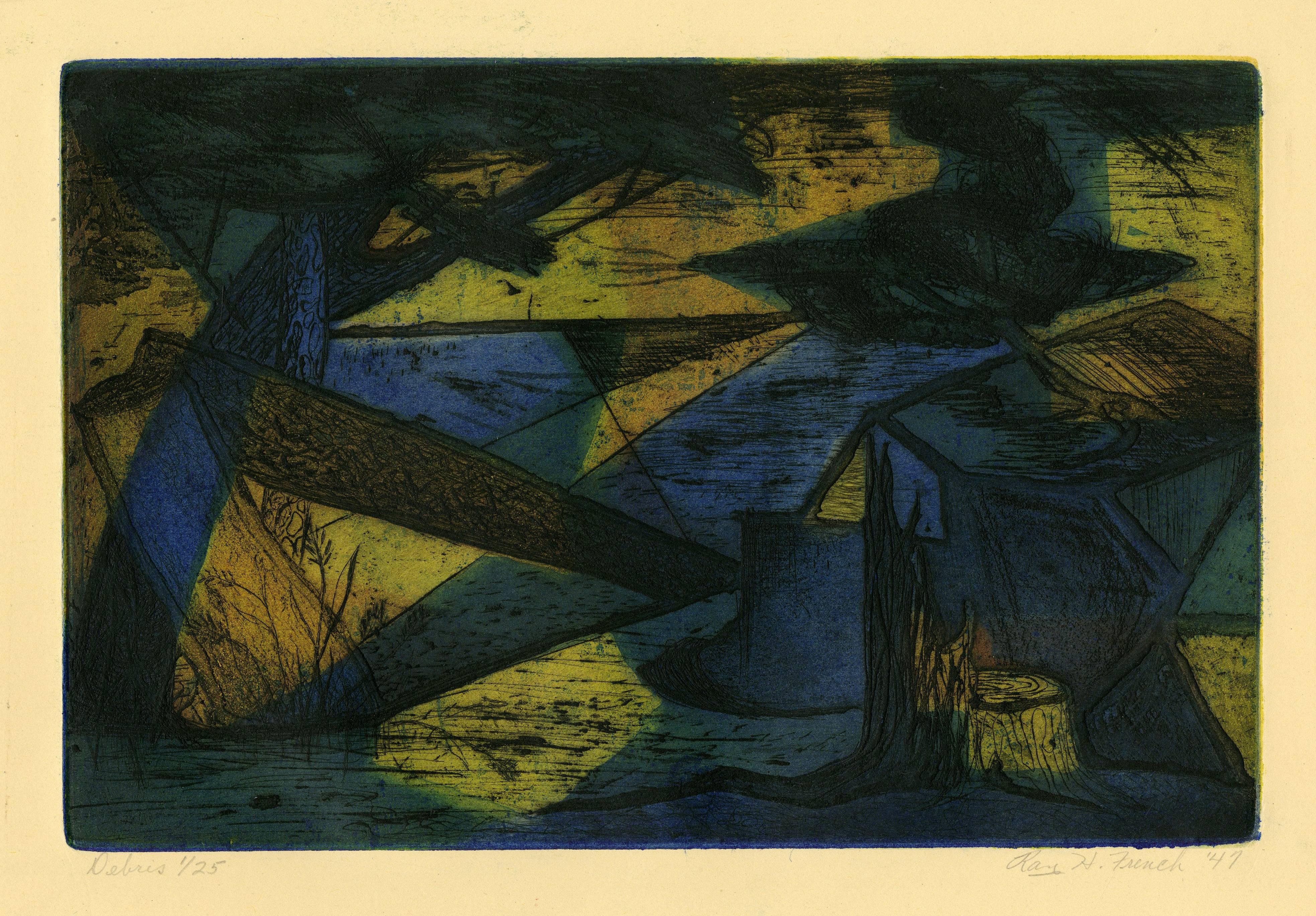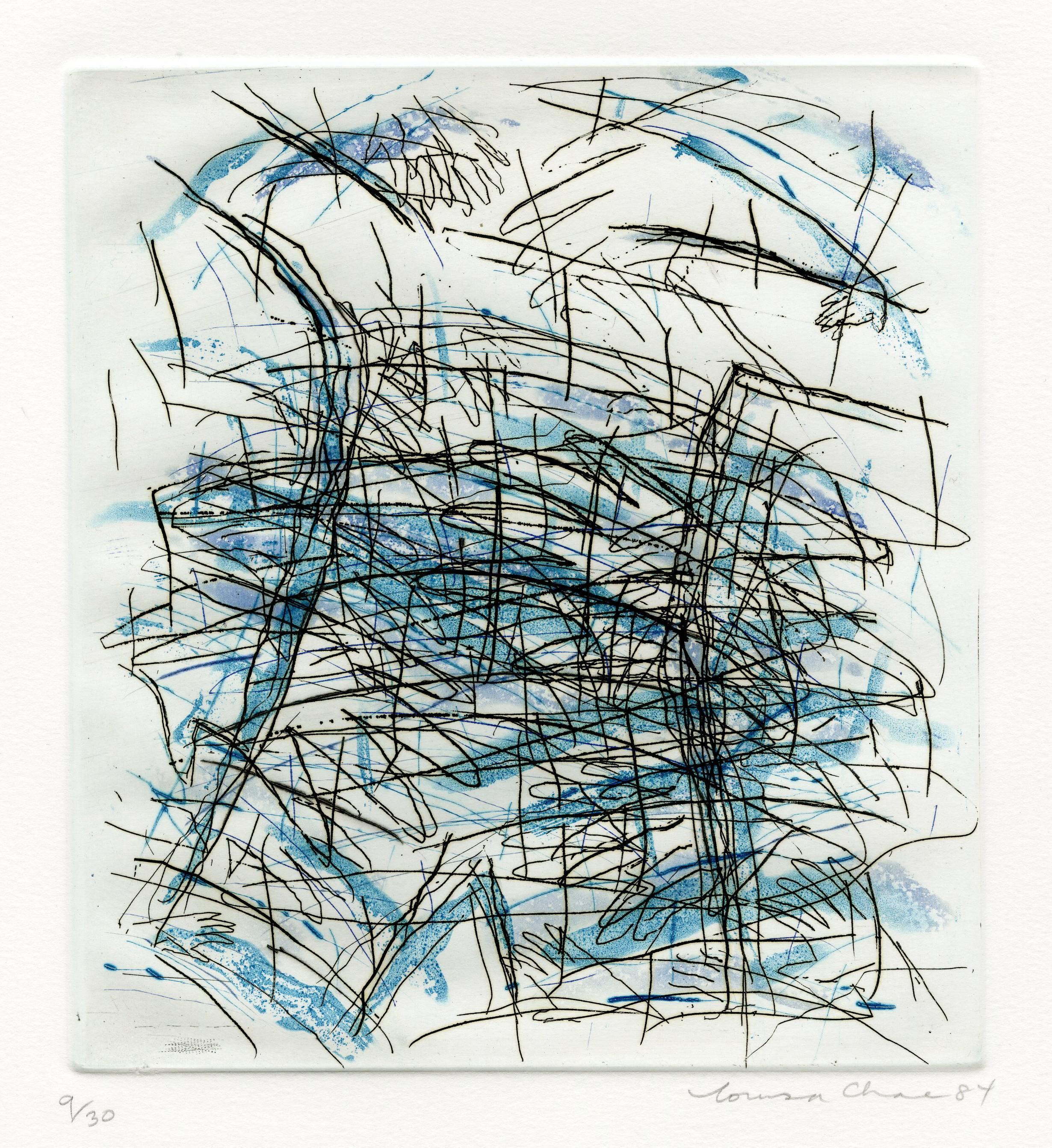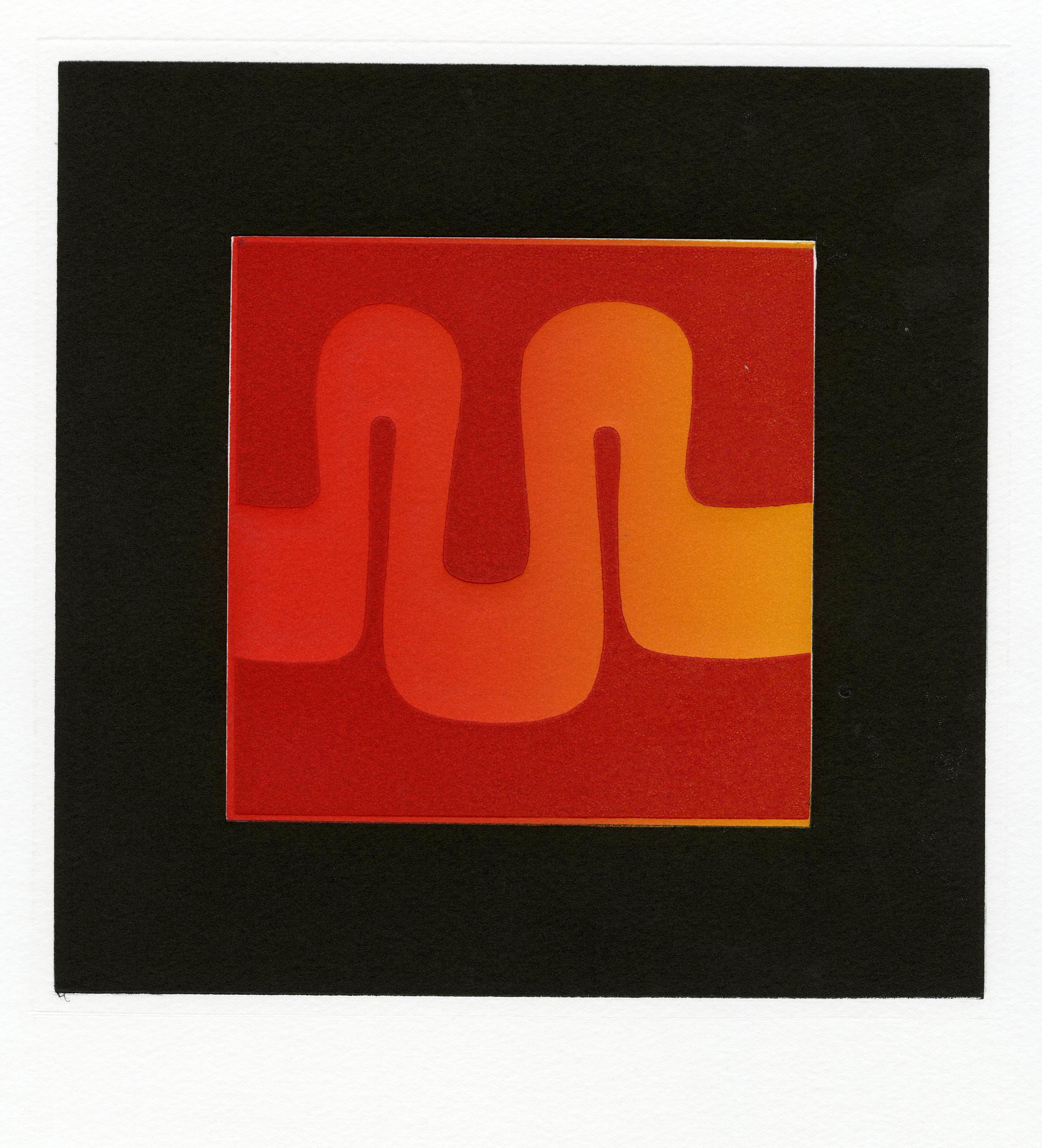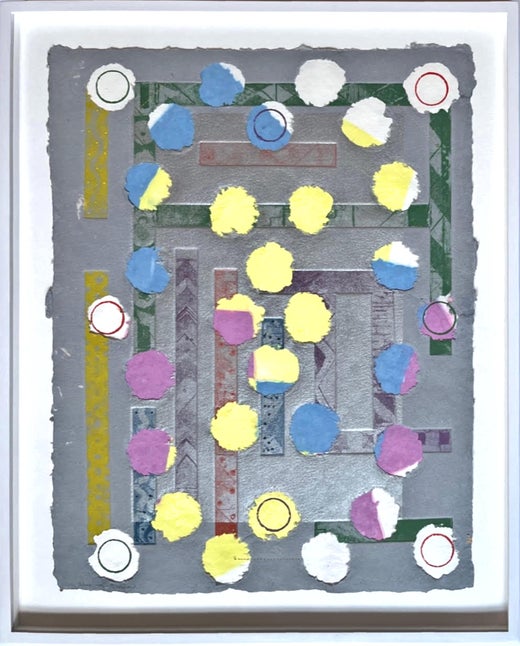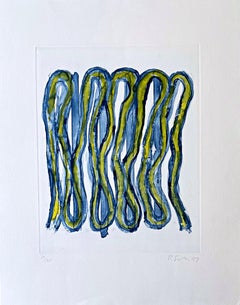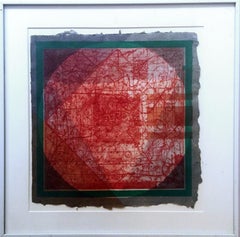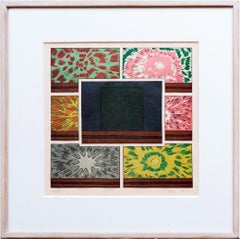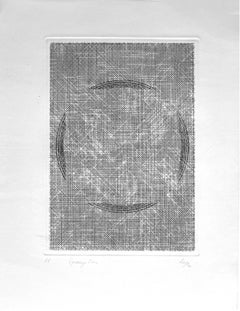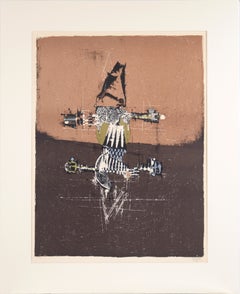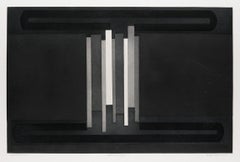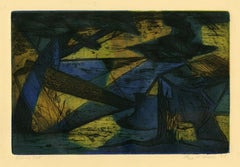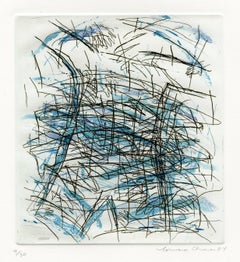Items Similar to Untitled mixed media geometric abstraction collage
Want more images or videos?
Request additional images or videos from the seller
1 of 9
Alan ShieldsUntitled mixed media geometric abstraction collageca. 1979
ca. 1979
About the Item
Alan Shields
Untitled mixed media geometric abstraction collage, ca. 1979
Etching and aquatint in colors with collage
Pencil signed and numbered 15/23 by Alan shields on the lower front
Frame Included
An excellent impression of this scarce mixed media collage multiple, hand signed and numbered on the front. This work is undated but the influences of Minimalism, Geometric Abstraction and Abstract Expressionism - are all apparent.
Floated and framed in the original vintage gold/bronze colored wood period frame
Measurements:
Frame:
41 x 33 x 1.5 inches
Artwork:
35.5 x 27.25 inches
Signed and numbered to lower edge '15/23 Alan Shields'. This work is number 15 from the edition of 23.
- Creator:Alan Shields (1944 - 2005, American)
- Creation Year:ca. 1979
- Dimensions:Height: 41 in (104.14 cm)Width: 33 in (83.82 cm)Depth: 1.5 in (3.81 cm)
- Medium:
- Movement & Style:
- Period:
- Condition:Work has not been examined outside of frame but it is in good overall condition and presents well.
- Gallery Location:New York, NY
- Reference Number:1stDibs: LU1745212972862
Alan Shields (1944 - 2005) is known for making art out of just about anything, often using sewing techniques coupled with painting, tie-dying, or wire bending. The critic Robert Hughes called Shields, "a brilliant bricoleur." Shields came to the notice of the art world virtually overnight after an exhibition in 1969 at the Paula Cooper Gallery, New York. By the mid-70's Shields was a focus of the contemporary art world and in 1973 was featured on the cover of Artforum. Today Shields' work can be found in the collections of many major American museums, including the Smithsonian Institute in Washington and the Museum of Modern Art in New York.
About the Seller
5.0
Platinum Seller
Premium sellers with a 4.7+ rating and 24-hour response times
Established in 2007
1stDibs seller since 2022
430 sales on 1stDibs
Typical response time: 2 hours
- ShippingRetrieving quote...Shipping from: New York, NY
- Return Policy
Authenticity Guarantee
In the unlikely event there’s an issue with an item’s authenticity, contact us within 1 year for a full refund. DetailsMoney-Back Guarantee
If your item is not as described, is damaged in transit, or does not arrive, contact us within 7 days for a full refund. Details24-Hour Cancellation
You have a 24-hour grace period in which to reconsider your purchase, with no questions asked.Vetted Professional Sellers
Our world-class sellers must adhere to strict standards for service and quality, maintaining the integrity of our listings.Price-Match Guarantee
If you find that a seller listed the same item for a lower price elsewhere, we’ll match it.Trusted Global Delivery
Our best-in-class carrier network provides specialized shipping options worldwide, including custom delivery.More From This Seller
View AllRichard Smith, Signature Etching & Aquatint Signed 17/25 British Pop Art pioneer
By Richard Smith
Located in New York, NY
Richard Smith
Signature, 1997
Etching and Aquatint
22 3/4 × 18 inches
Edition 17/25
Signed and numbered 17/25 in graphite on the lower front
RICHARD SMITH BIOGRAPHY
Charles Richard ...
Category
1990s Abstract Geometric Abstract Prints
Materials
Etching, Aquatint
Alan Shields Peace of the Rock mixed media abstract aquatint silkscreen signed
By Alan J. Shields
Located in New York, NY
ALAN SHIELDS
Peace of the Rock, 1974
Mixed Media Aquatint & Silkscreen
Signed and numbered 14/20 in graphite pencil recto
Frame included: held in original vintage frame
Measurements...
Category
1970s Abstract Geometric Abstract Prints
Materials
Aquatint, Screen
Cell with Explosions I, Line Engraving on Japanese Kozo paper, signed/N, Framed
By Peter Halley
Located in New York, NY
Peter Halley
Cell with Explosions I, 1993
Line Engraving on Japanese Wahon Creme Kozo Paper with glazed surface
Hand signed and numbered 49/50 by the artist on lower front
Original frame included: matted and framed in a wood frame
Rarely to market, this hand signed and numbered 1993 Peter Halley print is held in its original 1990s vintage frame. It's on elegant Japanese Wahon cream paper which is 100% Kozo paper with glazed surface. The specs on the paper are part of the design process.
Measurements:
Frame: 19 x 19 x 1 inches
Visible: 12 1/4 x 12 1/4 inches
Sheet: 15 7/8 x 15 1/4 inches
Peter Halley Biography
Peter Halley was born in 1953 in New York. He began his formal training at Phillips Academy in Andover, Massachusetts, from which he graduated in 1971. During that time, Halley read Josef Albers’s Interaction of Color (1981), which would influence him throughout his career. From 1973 to 1974 Halley lived in New Orleans, where he absorbed the vibrant cultural influences of the city, began using commercial materials in his art, and first became acquainted with the writings of earthwork artist Robert Smithson. In 1975 the artist graduated from Yale University, New Haven, with a degree in art history. After Yale, Halley returned to New Orleans, where he received an MFA in painting from the University of New Orleans in 1978. He had his first solo exhibition at the Contemporary Art Center, New Orleans, that same year.
In 1978 Halley spent a semester teaching art at the University of Louisiana, Lafayette. He has continued to teach throughout his career. In 1980, Halley moved back to New York and had his first solo exhibition in the city at PS122 Gallery. At this time, Halley was drawn to the pop themes and social issues addressed in New Wave music. Inspired by New York’s intense urban environment, Halley set out to use the language of geometric abstraction to describe the actual geometricized space around him. He also began his iconic use of fluorescent Day-Glo paint.
In 1984, Halley started to exhibit with the International With Monument gallery, becoming closely associated with the organization and its artists, who exhibited conceptually rigorous work in a market-savvy, coolly presented space that stood in stark contrast to the bohemian, Neo-Expressionist flair of the East Village art scene at the time. In 1986, an exhibition of four artists from International With Monument at the Sonnabend Gallery in New York heralded the group’s growing success. By the late 1980s, Halley was exhibiting with prominent galleries in the United States and Europe. In 1989, an exhibition of his paintings traveled to the Museum Haus Esters, Krefeld, Germany; Maison de la culture et de la communication de Saint-Étienne, France; and Institute of Contemporary Arts, London. From 1991 to 1992, a retrospective toured Europe, with presentations at the CAPC Musée d’art contemporain de Bordeaux, France; Musée d’art contemporain, Lausanne, Switzerland; Museo nacional centro de arte Reina Sofía, Madrid; and Stedelijk Museum, Amsterdam. In 1992, the Des Moines Art Center hosted his first solo exhibition at a U.S. museum.
While developing his visual language, Halley became interested in French post-structuralist writers, including Jean Baudrillard, Guy Debord, Michel Foucault, and Paul Virillio, all of whom shared his concern with the character of social spaces in a post-industrial society. In 1981, he published his first essay “Beat, Minimalism, New Wave, and Robert Smithson” in Arts, a New York–based magazine that would publish eight of his essays before the decade’s end. Halley’s writings became the basis for Neo-Geometric Conceptualism (also known as Neo-Geo), the offshoot of Neo-Conceptualism associated with the work of Ashley Bickerton, Halley, and Jeff Koons. In 1988, the artist’s writings were anthologized in Collected Essays, 1981–1987, and again in 1997 in a second anthology, Recent Essays, 1990–1996.
In the mid-1990s, Halley began to produce site-specific installations for museums, galleries, and public spaces. These characteristically brought together a range of imagery and mediums, including paintings, wall-size flowcharts, and digitally generated wallpaper prints. Halley has executed permanent installations at the Dallas/Fort Worth International Airport, Texas, and the Gallatin School of Individualized Study at New York University. In 2011, his installation of digital prints Judgment Day...
Category
1990s Abstract Geometric Abstract Prints
Materials
Rice Paper, Etching
Squaring Four, Etching on off-white paper unique signed AP geometric abstraction
By Vincent Longo
Located in New York, NY
Vincent Longo
Squaring Four, 1972
Etching on off-white J.B. Green paper
Signed, named, dated, and numbered AP by the artist on the front
20 × 15 inches
Unframed
A unique signed, titl...
Category
1970s Abstract Geometric Abstract Prints
Materials
Etching
di Auguri
By Arnaldo Pomodoro
Located in New York, NY
Arnaldo Pomodoro
di Auguri, 1992-1993
Etching on art paper
Hand signed, numbered 69 from an edition of 100 and dated by the artist on the front
Frame Included
This uncommon limited e...
Category
1990s Abstract Geometric Abstract Prints
Materials
Etching
James Siena, geometric abstraction, Christmas print, signed/N, 8/54 Framed
By James Siena
Located in New York, NY
James Siena
Untitled geometric abstraction (The Christmas Print), 2006
3-Color etching on paper with deckled edges
Signed, dated and numbered 8/54 in graphite pencil on the front
Fra...
Category
Early 2000s Abstract Geometric Abstract Prints
Materials
Etching
You May Also Like
"Haarlem" Aquatint Etching on Paper
By Johnny Friedlaender
Located in Soquel, CA
Bold abstract aquatint by Johnny Friedlaender (Polish-French, 1912-1992). Comprised of two main sections, this piece is full of detail and texture. The upper layer is a reddish tan, whereas the bottom layer is a rich brown. Geometrical shapes are arranged such that they almost form mirror images of each other, but vary enough to create interest and a sense of movement.
Signed in the lower right corner.
Numbered 56/350 in the lower left corner.
Includes original certificate of authenticity.
Presented in a new cream mat with foamcore backing.
Mat size: 42"H x 32"W
Paper size: 33.75"H x 24.5"W
Johnny Friedlaender was a leading 20th century artist, whose works have been exhibited in Germany, France, Netherlands, Italy, Japan and the United States. He has been influential upon other notable artists, who were students in his Paris gallery. His preferred medium of aquatint etching is a technically difficult artistic process, of which Friedlaender has been a pioneer.
Johnny Gotthard Friedlaender was born in Pless (Silesia) and his early studies were in Breslau under Otto Mueller. In 1936 Friedlaender journeyed to Czechoslovakia, Switzerland, Austria, France and Belgium. At the Hague he held a successful exhibition of etchings and watercolours. He fled to Paris in 1937 as a political refugee of the Nazi regime with his young wife, who was an actress. In that year he held an exhibition of his etchings which included the works: L 'Equipe and Matieres et Formes. From 1939 to 1943 he was interned in a series of concentration camps, but survived against poor odds.
After freedom in 1944 Friedlaender began a series of twelve etchings entitled Images du Malheur with Sagile as his publisher. In the same year he received a commission to illustrate four books by Freres Tharaud of the French Academy. In 1945 he performed work for several newspapers including Cavalcade and Carrefour. In the year 1947, he produced the work Reves Cosmiques, and in that same year he became a member of the Salon de Mai, which position he held until 1969. In the year 1948 he began a friendship with the painter Nicolas de Stael and held his first exhibition in Copenhagen at Galerie Birch. The following year he showed for the first time in Galerie La Hune in Paris. After living in Paris for 13 years, Friedlaender became a French citizen in 1950.
Friedlaender expanded his geographic scope in 1951, and exhibited in Tokyo in a modern art show. In the same year he was a participant in the XI Trienale in Milan, Italy. By 1953 he had produced works for a one-man show at the Museum of Neuchâtel and exhibited at the Galerie Moers in Amsterdam, the II Camino Gallery in Rome, in São Paulo, Brazil and in Paris. He was a participant of the French Italian Art Conference in Turin, Italy that same year.
Friedlaender accepted an international art award in 1957, becoming the recipient of the Biennial Kakamura Prize in Tokyo. In 1959 he received a teaching post awarded by UNESCO at the Museum of Modern Art in Rio de Janeiro. By 1968, Friedlaender was travelling to Puerto Rico, New York and Washington, D.C. to hold exhibitions. That year he also purchased a home in the Burgundy region of France. 1971 was another year of diverse international travel including shows in Bern, Milan, Paris, Krefeld and again New York. In the latter city he exhibited paintings at the Far Gallery, a venue becoming well known for its patronage of important twentieth century artists.
From his atelier in Paris Friedlaender instructed younger artists who themselves went on to become noteworthy, among them Arthur Luiz Piza, Brigitte Coudrain, Rene Carcan...
Category
1970s Abstract Geometric Abstract Prints
Materials
Paper, Etching, Aquatint
$1,160 Sale Price
20% Off
Compression
By Will Barnet
Located in New York, NY
This large, striking color etching and aquatint is an artist's proof, aside from the edition of 20. Signed, titled and inscribed "AP" in pencil by Barnet.
Category
1960s Abstract Geometric Abstract Prints
Materials
Etching, Aquatint, Lithograph
Debris
By Ray H. French
Located in Fairlawn, OH
Debris
Etching, engraving and color aquatint, 1947
Signed, dated, titled and number
Edition: 25 (1/25), never fully realized
Created in the artist's first year studying at the Univer...
Category
Mid-20th Century Abstract Geometric Abstract Prints
Materials
Engraving, Etching, Aquatint
Untitled (Undertow Variant)
By Louisa Chase
Located in Fairlawn, OH
Untitled (Undertow Variant)
Etching and aquatint printed in colors
Signed and numbered in pencil (see photos)
Edition: 30 (9/30) see photo
Condition: Excellent
Image: 7 7/8 x 7"
She...
Category
1980s Abstract Geometric Abstract Prints
Materials
Etching, Aquatint
Neon
By Carlos Davila 1
Located in Fairlawn, OH
Neon
Intaglio Etching, c. 1970
Signed, titled and numbered in pencil
Edition: 99 (76/99)
Image size: 7 1/2 x 7 1/2 inches
Sheet size: 22 x 17 inches
Condition: Excellent
Carlos Dávil...
Category
1970s Abstract Geometric Abstract Prints
Materials
Aquatint
Conversation III
Located in New York, NY
About the Series:
Gilliam began the series Life Lines in 2017 after recently coming into possession of MRI scans of her brain. The scans, which she spent hours pouring over, both fas...
Category
2010s Abstract Geometric Abstract Prints
Materials
Etching, Aquatint
